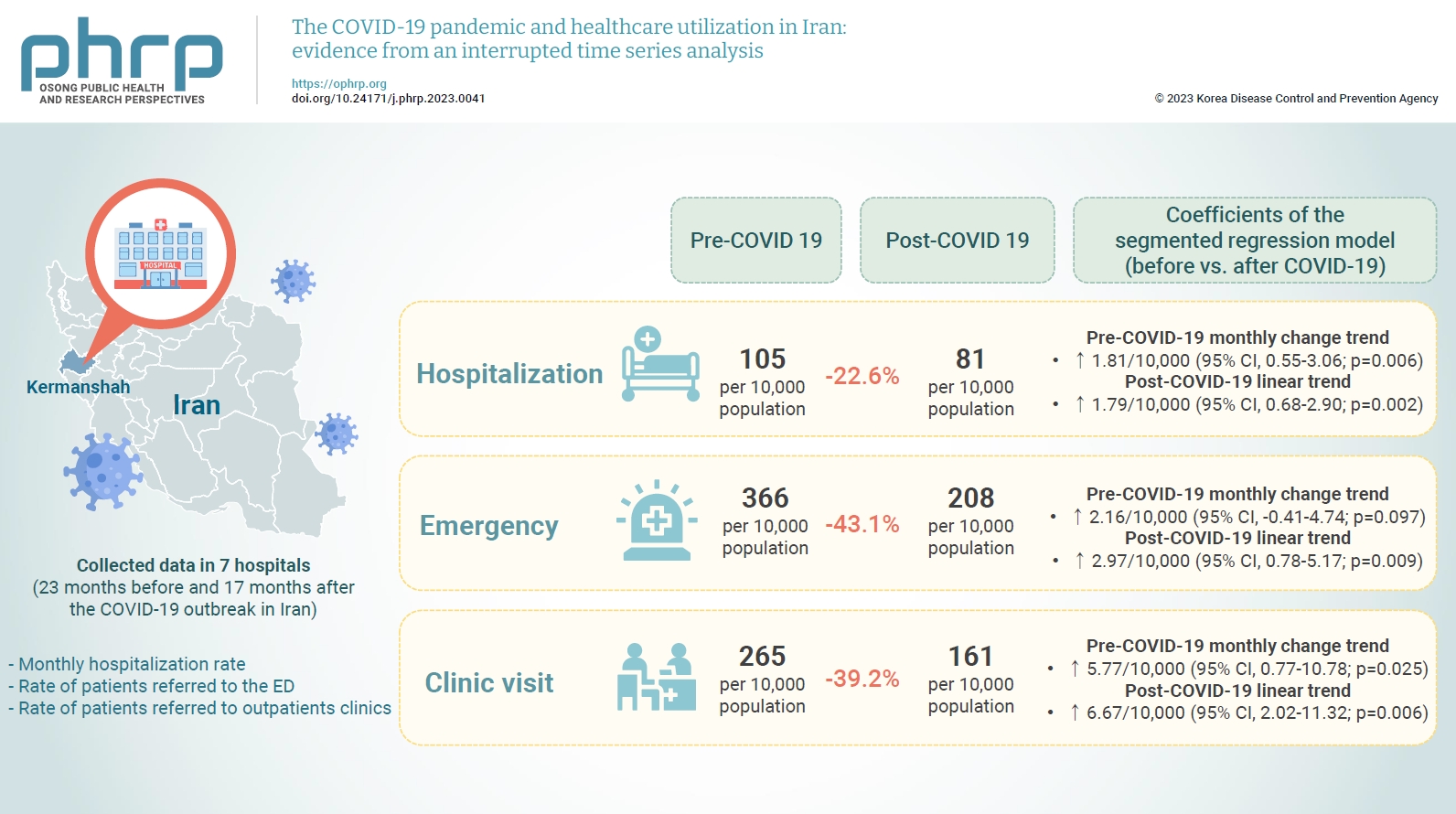- The COVID-19 pandemic and healthcare utilization in Iran: evidence from an interrupted time series analysis
-
Monireh Mahmoodpour-Azari, Satar Rezaei, Nasim Badiee, Mohammad Hajizadeh, Ali Mohammadi, Ali Kazemi-Karyani, Shahin Soltani, Mehdi Khezeli
-
Osong Public Health Res Perspect. 2023;14(3):180-187. Published online June 22, 2023
-
DOI: https://doi.org/10.24171/j.phrp.2023.0041
-
-
 Graphical Abstract Graphical Abstract
 Abstract Abstract
 PDF PDF
 - Objectives
This study aimed to examine the effect of the coronavirus disease 2019 (COVID-19) outbreak on the hospitalization rate, emergency department (ED) visits, and outpatient clinic visits in western Iran.
Methods
We collected data on the monthly hospitalization rate, rate of patients referred to the ED, and rate of patients referred to outpatient clinics for a period of 40 months (23 months before and 17 months after the COVID-19 outbreak in Iran) from all 7 public hospitals in the city of Kermanshah. An interrupted time series analysis was conducted to examine the impact of COVID-19 on the outcome variables in this study.
Results
A statistically significant decrease of 38.11 hospitalizations per 10,000 population (95% confidence interval [CI], 24.93–51.29) was observed in the first month of the COVID-19 outbreak. The corresponding reductions in ED visits and outpatient visits per 10,000 population were 191.65 (95% CI, 166.63–216.66) and 168.57 (95% CI, 126.41–210.73), respectively. After the initial reduction, significant monthly increases in the hospitalization rate (an increase of 1.81 per 10,000 population), ED visits (an increase of 2.16 per 10,000 population), and outpatient clinic visits (an increase of 5.77 per 10,000 population) were observed during the COVID-19 pandemic.
Conclusion
Our study showed that the utilization of outpatient and inpatient services in hospitals and clinics significantly declined after the COVID-19 outbreak, and use of these services did not return to pre-outbreak levels as of June 2021.
- The role of risk perception, risk communication, and demographic factors in COVID-19 preventive behaviors: an online survey in Iran
-
Mansour Rezaei, Nader Rajabi Gilan, Ali Almasi, Mehdi Khezeli, Fatemeh Jamshidi Nazar, Zahra Jorjoran Shushtari, Yahya Salimi, Farid Najafi, Neda Sarabi, Shahram Saeidi, Saeid Saeidi
-
Osong Public Health Res Perspect. 2022;13(4):282-289. Published online August 31, 2022
-
DOI: https://doi.org/10.24171/j.phrp.2021.0345
-
-
2,957
View
-
57
Download
-
3
Web of Science
-
3
Crossref
-
 Abstract Abstract
 PDF PDF
- Objectives
This study investigated preventive behaviors toward coronavirus disease 2019 (COVID-19) and related factors in a Kurdish Iranian sample.
Methods
This online survey was conducted among the population aged 18 and above in Kermanshah Province, in western Iran, in April 2020. Samples were invited and recruited through social media. Data were collected using a questionnaire consisting of 4 sections (questions on demographic variables, risk perception, risk communication, and COVID-19 preventive behaviors) and analyzed using Stata ver. 8.
Results
The Pearson correlation test showed that risk communication was significantly correlated with COVID-19 preventive behaviors (r=0.320, p<0.01). In the final model, where the explanatory power increased with the entry of the risk communication variable, the variables explained a total of 14% of variance in COVID-19 preventive behaviors. Sex (β=−0.482), risk perception (β=0.047), and risk communication (β=0.662) were significant determinants.
Conclusion
Risk communication and risk perception related to COVID-19, as well as being a woman, were determinants of COVID-19 preventive behaviors.
-
Citations
Citations to this article as recorded by  - Understanding Australian Government Risk Communication Early in the COVID-19 Pandemic: Sociodemographics, Risk Attitudes and Media Consumption
Yiyun Shou, Louise M. Farrer, Amelia Gulliver, Eryn Newman, Philip J. Batterham, Michael Smithson
Journal of Health Communication.2023; 28(4): 254. CrossRef - Risk perception and avoidance of preventive behavior on the COVID‐19 among cancer patients
Mehdi Khezeli, Asghar Tavan, Sajjad Narimani, Vahideh Hoseini, Elham Zare Hosseinzadeh, Parisa Motamedi
Health Science Reports.2023;[Epub] CrossRef - The Role of Risk Communication in Shaping Health-Protective Behavior Amid the COVID-19 Pandemic in Thailand
Suphunnika Termmee, Bing Wang
Social Sciences.2023; 12(10): 551. CrossRef
|